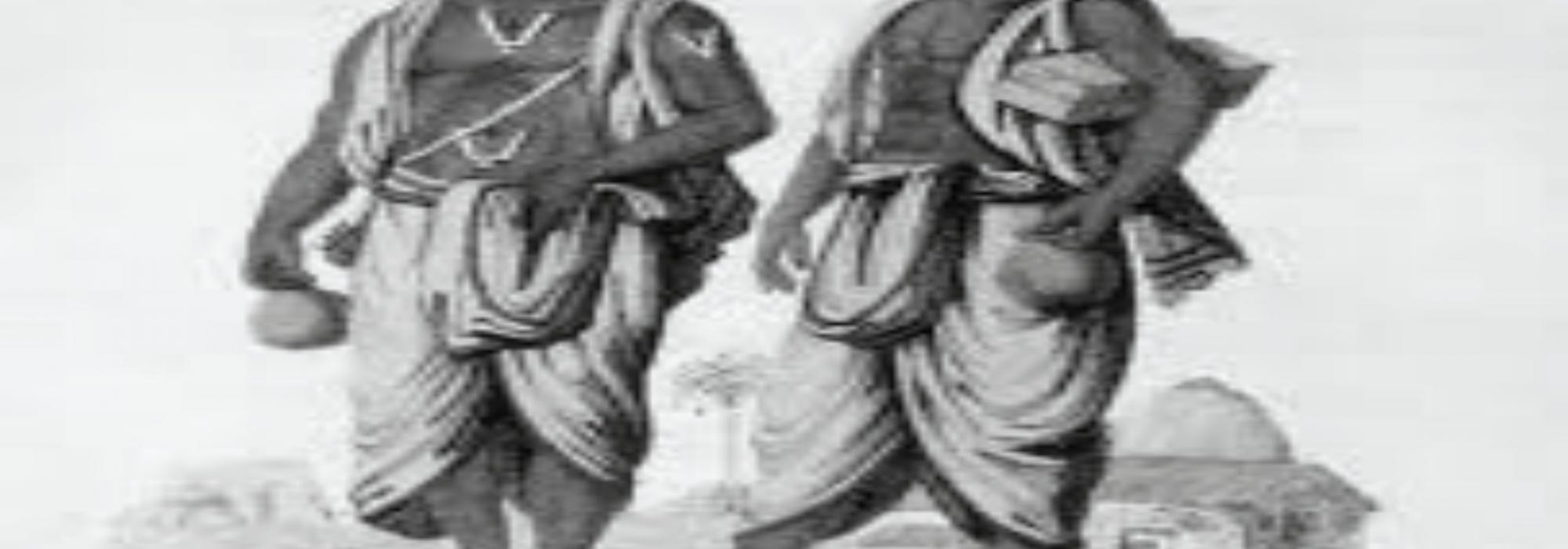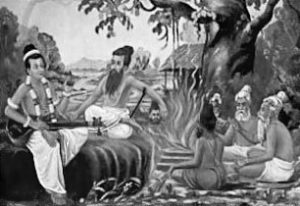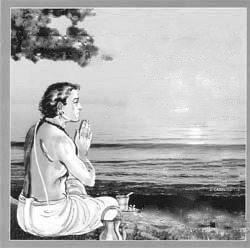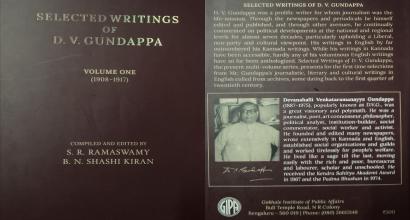Translator’s Note: This is the second and concluding part of the iconic D.V. Gundappa’s series profiling the life and lifestyles of numerous traditional Vedic scholars. The first part translated and published on Prekshaa Journal is available at this link.
The present essay appeared as the Upasamhaara, or epilogue in May 1972 for the volume titled Vaidikadharma Sampradaayastharu (Traditional Vedic Scholars) forming part of his acclaimed Jnapaka Chitrashaale (The Art School of Memories) series that first appeared in the daily “Kannada Prabha.”
Translated by Sandeep Balakrishna.
The societal pictures portrayed in this series primarily relate to Vaidika Brahmins or traditional Vedic scholars.
Translator’s note: Vaidika Brahmins refer to those Brahmins primarily engaging in officiating pujas, rituals, and ceremonies on a wide range of occasions from birth till death. They also teach the Vedas, Shastras, Puranas, Sanskrit, and other sacred learning associated with Sanatana Dharma in the traditional fashion. Throughout this essay, the phrase “traditional Vedic scholars” has been used to signify them.
I regard traditional Vedic scholars as one of the most important components among the treasures of our country. And I continue to believe that even today, there exist hundreds of people who share my opinion.
The wealth of our country truly lies in our Vedic Shastras and not elsewhere. All Indians have a desire for India to progress and earn renown in several worldly endeavours such as military arsenal, machinery and industries, lakes, canals, and buildings. It’s both obvious and just. There’s no objection to state that earning this sort of material wealth is a great achievement of human effort.
But no matter how far India progresses in the achievement of this kind of material wealth, there will always be numerous other countries as competition. Indeed, I feel that our desire for India to equal England, Germany, America, and Russia in material adventures at some point is itself an adventure. It’s our duty to attempt; so let’s attempt. But hoping that only we will get the top spot is an argument of the extreme sort.
But the one field which doesn’t present any such competition is culture: specifically, the spiritual culture of India. This spiritual culture is the best and the finest of India’s wealth. If we don’t account for or neglect this spiritual culture, there’s no other area which India can take pride in. Forget pride, there’s no path where India can become useful to the world.
We can traverse a hundred or thousand miles further on the path of scientific endeavor, business ventures, sculptural and architectural achievements and material wealth. But no matter how much such progress, it’s possible for other nations as well. Which means, India is like other nations.
Let’s accumulate, let’s pay, let’s eat,
Let’s sleep and awake again
Our Dasas (Vishnu Bhaktas in the Kannada-speaking countries in medieval India) summarize the essence of our outward lives thus. It’s the same for all nations. And it applies equally not just to the human but also to the world of beasts.
Fundamental Elements
The superiority of the human lies in his/her inner life. One of the elevating facets of this inner life is culture. And one of the key fundamentals of this culture is spiritual illumination, spiritual fragrance.
The learning that radiates this spiritual culture’s theoretical tenets and applicatory forms are the Vedas. The essence of the Vedas flow in hundreds of rivers and culverts in poetry like Ramayana and Mahabharata, in digests like the Manusmriti, and in poems like Raghuvamsham and Nalacharitra.
Thus, those who protect and preserve the knowledge of our country’s spiritual culture, its organic arts, and its traditional customs in an unbroken manner become the preservers and custodians of the initial capital of this country’s cultural treasure. They are the nucleus of Indian Culture.
How such people used to live their lives fifty or sixty years ago, how they had escaped the trappings of modern civilization, how they found much in little and remained content, and how they remained steadfast to their Swadharma: if these essays helped cast a guiding light on these aspects, I can stay content feeling that my labours have been fruitful.
Some Vedic traditionalists and Shastris might exist in pockets even today leading such simple, plain, and harmless lives. I’ve heard to my joy that there still exist such great Vedic traditionalists in the Gokarna region in North Karnataka. But then, for how many more years or decades can such folks exist in our country? Aren’t contemporary life-circumstances detrimental to them? — This suspicion repeatedly squeezes my mind. I’m hearing that the number of traditional Vedic families has already gone down in our countryside. I’m also hearing that even in hundreds of large villages, there are no longer any competent Purohitas who can conduct even rudimentary Pujas and Shraddhas (annual death ceremony performed for a family member).
This is an extremely lamentable fact for people who have faith in our cultural heritage. The abundance of spiritual learning is declining. Vedic study is becoming feeble. The number of GhanapaaTis (a mode of reciting the Veda[i]) in our country who have undertaken a complete and rigorous study can’t even be counted on the fingers of one hand.
Thus, the very treasure trove of knowledge that is the life-form of Bharata, that which is its very Atman, is vanishing before our eyes.
Solution
So how can we set right this lacuna?
And who are endowed with the conviction to set this right? If we first locate them, we can then think of what they can do.
I will humbly lay down a few thoughts here:
- The first thing that needs to occur is a resolve in the minds of the Vaidikas. They need to take a vow that no matter the hardships they face, no matter the poverty, they’ll never abandon their ancestral knowledge.
- Other folks, especially Brahmins, need to take a vow that they’ll not neglect or deride Vedic Shastras and Vaidika Brahmins.
- Traditional Vedic scholars need to completely forgo asking help from the Government and Government officials.
- Traditional Vedic scholars are never opposed to matters concerning the Government. Indeed, the constant prayer of the Vedic Shastras is that Government must function smoothly: KalpatE ha vai tatra prajAbhyO yOgakShemaH. But Vaidikas must never visit ministers and other powerful folks seeking anything. By seeking, they send a strong signal that they will remain obedient to folks who are wealthy. This sort of cravenness isn’t good for anybody; for Vaidikas especially, it’s totally unwarranted.
- It’s but natural in these times of distress for traditional Vedic scholars to greatly worry about livelihood. But Vaidikas mustn’t abandon their ancestral Dharma in their attempts to tide over this worry. To the extent possible, they need to retain and protect their ancestral learning. Those who work in offices and factories usually have their evening to themselves. They need to return home as early as possible in the evening and must devote the interval before going to work the next day, by engaging in systematic Vedic and Shastric study and similar activities. This duration is little. What can be accomplished is also meagre. Notwithstanding, they must carry it on with a mental attitude of a Vrata, a scared vow.
- Even those Brahmins who’re engaged in worldly professions too, must have this mental attitude and preserve virtuous customs and traditions as far as possible. The atmosphere at home must be Vedic.
- Our Purohitas need to provide encouragement to Vedic Karmas (rituals). Meaning, they mustn’t unnecessarily increase their honorarium (Dakshina). This is where Vaidikas earn infamy. I’ve personally witnessed several instances of the reason for this infamy…I’ve also personally witnessed an instance where a person wanting to perform his father’s annual death ceremony couldn’t afford the costs. When he confided this to my traditional Vedic scholar friend, he said, “You must not forsake such a sacred duty. Come home. I’ll take care of everything,” and performed the Karma from his own money. Therefore, I won’t criticize all the Vaidika Brahmins. There are numerous noble folks among them. But the ignoble actions of a few will wipe out the virtuous deeds of a hundred good folks. The allegation that all Vaidika Brahmins have a hasty desire for Dakshina has given birth to obscenities like “Priestcraft.” The first task of devout Hindus is to erase such allegations. And it’s the traditional Vedic scholars who need to aid them. They need to reduce the quantum of money as far as possible on occasions like marriage, Upanayana[ii], and other ceremonies. The essential Karma must take place but let the cost not escalate.
- There’s another aspect attached to this—and it’s related to the worldly (non-Vedic) folks. These folks need to be magnanimous as far as possible while giving Daana and They shouldn’t calculate on the basis of “X amount per hour, or a half hour.” They need to show generosity to Purohitas and Vaidika Brahmins to the extent their means permit.
What was said so far pertained to personal conduct. Now there’s a significant work that needs to occur at the level of the society. And it needs to occur at the level of the heads of our MaThas. Every single MaTha must convene an annual gathering and give honorarium to both teachers and students.
The Guru of Sri Kanchi Kamakoti MaTha has been systematically undertaking this kind of work over several years. This apart, a corpus must be established and provided to those who are engaged in Vedic study. The objective and condition must be to enable them to earn a trouble-free living in the form of land or other means and engage only in the dissemination of Vedic knowledge.
One mustn’t expect any sort of assistance and encouragement for Vedic learning from the Government. Governments of today aren’t those of the Rajas and Maharajas. People of various hues populate today’s Governments. And those who have no regard for the Vedas are powerful. Taking assistance from such Governments will make it convenient for people of inimical faiths, under the garb of reform, to intrude into Vedic systems and Hindu society.
Adversity
Overall, the current situation is largely adverse. In the future, circumstances in the country will progressively reduce the opportunity for purity, simplicity, and tranquility in life. The slogan of “Indian Culture” and constructing the building of “strengthening Sanskrit”—no matter how extraordinarily these have progressed, it appears impossible to expect support or sympathy from the Government in the matter of preserving and perpetuating Vedas and Shastras.
Vedas and Shastras must take nourishment and grow independently: from the genuine devotion and zeal among people. All the true advocates and adherents of Indian Culture must introspect and contemplate on the ways to accomplish this.
Nobody should think that the matter of preserving the Vedas is related only to Brahmins and is inapplicable to other Varnas. The preservation and safeguarding of the Vedas is the duty of all Hindus as a civilization. The Vedic Culture is the property that uniformly belongs to Hindus of all Varnas. Why just the Hindu society, the Vedic Culture is indeed an extremely invaluable treasure for all nations.
The Vaidika Brahmin, the traditional Vedic scholar is akin merely to its trustee and custodian. He needs to preserve his tradition of learning for the use and well-being of others.
It is for the use of the entire Hindu society, for the welfare of the various Varnas of Hinduism and indeed, for the prosperity of the entire world that traditional Vedic scholars need to be protected.
Concluded
Notes
[i] A GhanapaaTi is one who has mastered reciting the Veda in the “Ghana” mode where the words of a Vedic mantra are repeated back and forth in a bell shape
[ii] Upanayana can also be loosely translated as “Sacred Thread Ceremony,” and “Ritual Investiture.”










































